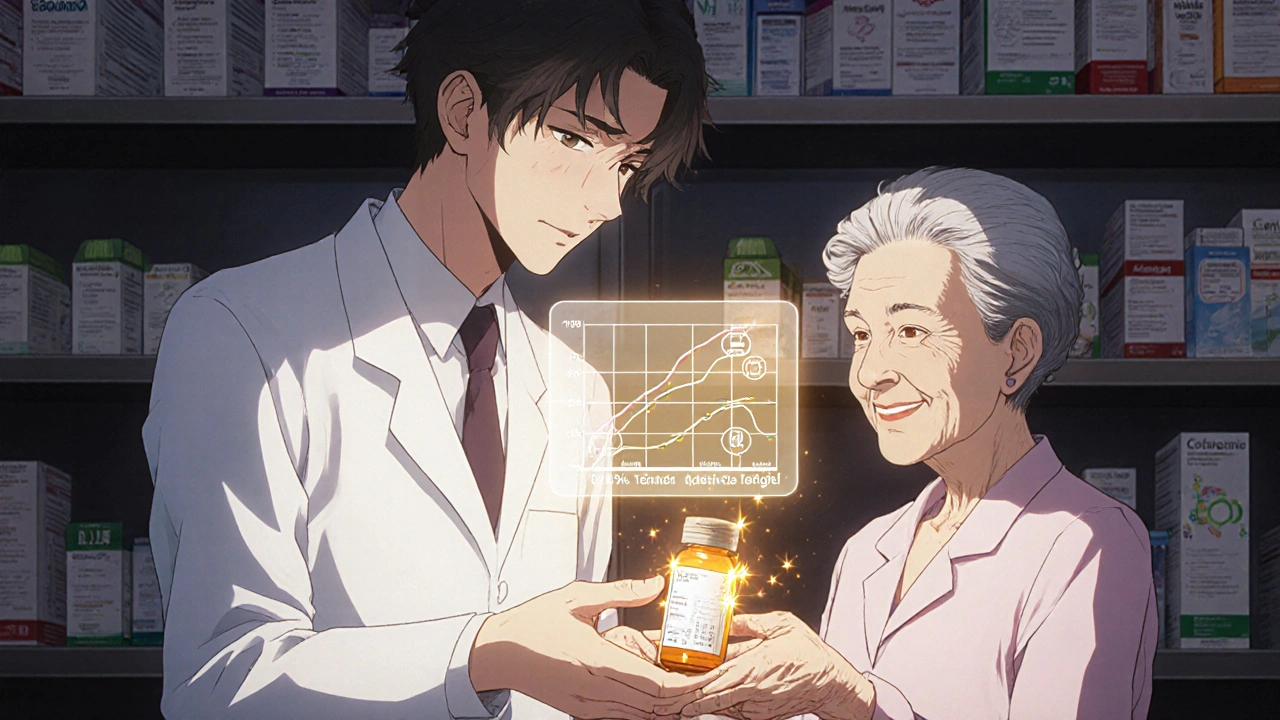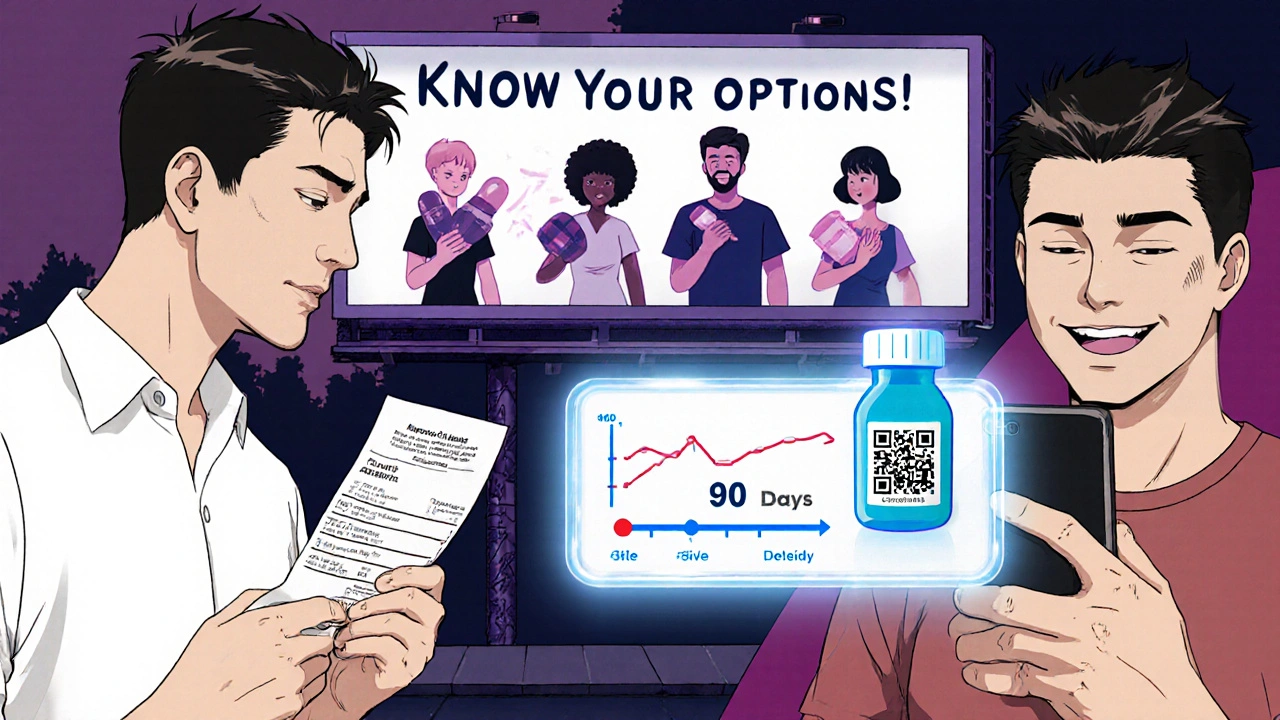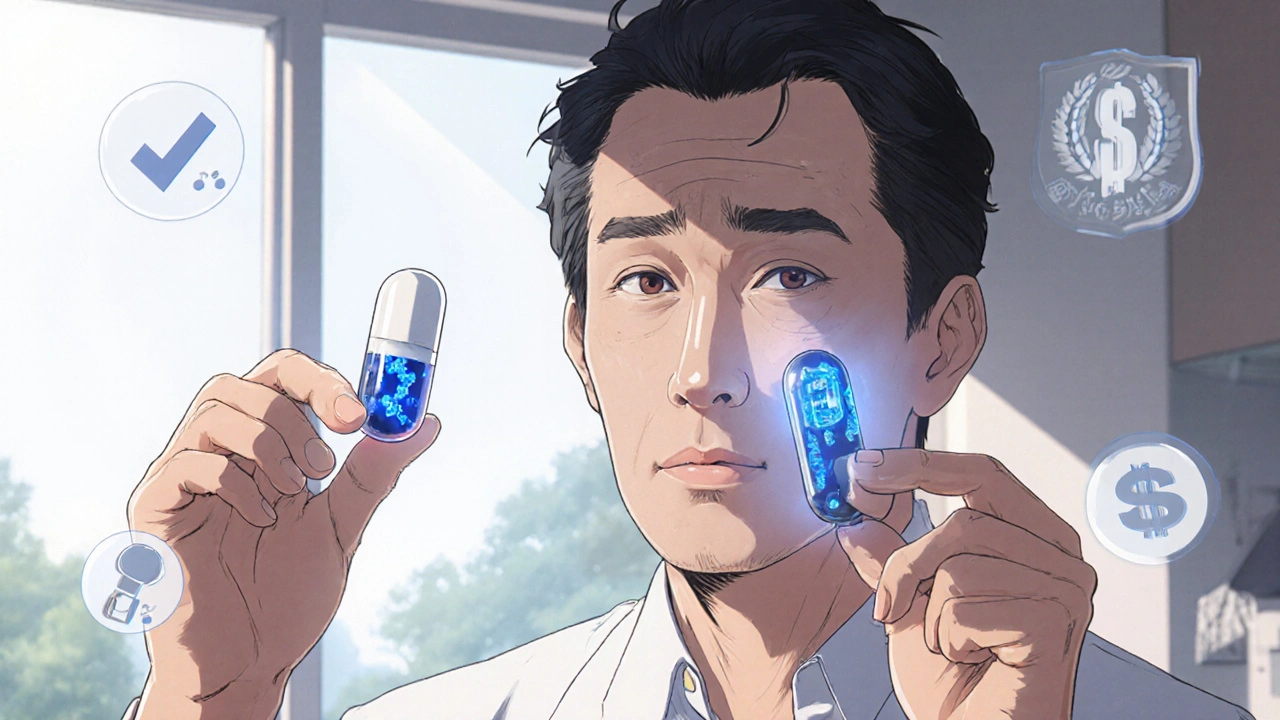When you pick up a prescription, do you ever wonder why the pill looks different from last time? Maybe it’s a different color, shape, or has a strange marking on it. If you’ve ever hesitated to take it-thinking, Is this really the same?-you’re not alone. Millions of people in the U.S. and around the world feel the same way. But here’s the truth: generic medications are not cheaper because they’re weaker. They’re cheaper because they don’t carry the marketing costs of big brands.
The FDA requires that generic drugs contain the exact same active ingredient, strength, dosage form, and route of administration as the brand-name version. They must also prove they’re absorbed into the body at the same rate and to the same extent. That’s called bioequivalence. The acceptable range? 80% to 125%-meaning your body gets nearly the same amount of medicine, every time. This isn’t a guess. It’s tested in clinical trials with real people. And yet, nearly one in three patients still worry that generics won’t work as well.
Why Do People Doubt Generic Medications?
The distrust doesn’t come from nowhere. It comes from experience, appearance, and messaging.
Think about it: when you’ve been taking a brand-name drug for years, your body gets used to how it looks, how it tastes, even how it feels in your hand. Then your pharmacist hands you a new pill-same active ingredient, but different color, different shape, maybe even a different name on the label. It’s jarring. And when something changes in your health, even slightly, it’s natural to blame the new pill. A patient switching from brand-name Lyrica to generic pregabalin might feel nauseous and assume the generic is the culprit. But what if the nausea was caused by a change in diet, stress, or even a different filler in the pill? The inactive ingredients-like dyes or binders-can vary between brands. They don’t affect how the medicine works, but they can affect how your stomach reacts.
Then there’s the myth that generics have less active ingredient. A 2024 survey found that 33% of patients believe generics contain only 80% of the active drug. That’s false. The FDA requires generics to deliver between 90% and 110% of the active ingredient compared to the brand. Not 80%. Not 85%. 90-110%. That’s tighter than most people realize.
And let’s not forget the influence of advertising. Brand-name companies spend billions on TV ads that make their drugs feel special, cutting-edge, even luxurious. Generic drugs? They don’t run commercials. So when you see a slick ad for a brand-name drug, your brain starts to associate it with quality. The generic? It’s just a little white pill in a brown bottle. No story. No celebrity. No hype. That’s not a flaw in the medicine-it’s a flaw in perception.
Who Trusts Generics-and Who Doesn’t?
Trust isn’t the same for everyone. Research shows it’s tied to age, income, education, and even where you live.
Older adults, especially those over 60, are more likely to trust generics. Why? Because they’ve lived through the cost of medicine. Many have watched their fixed incomes shrink while drug prices rose. In one study, 71% of seniors over 60 said they believed generics were safe. Compare that to younger adults, where trust drops to around 58%. For them, the fear of something going wrong feels more personal.
Employed people also show higher trust-82% say generics are safe. Why? Because they’re more likely to have insurance that pushes generics. They’ve had the experience of switching and seeing no change in how they feel.
But in countries like Greece, only about 70% of patients trust generics when their doctor suggests them. In the U.S., that number is 94%. Why the gap? In Greece, doctors rarely explain the science behind generics. In the U.S., many providers now use visual aids-side-by-side diagrams showing identical active ingredients-to show patients that the medicine is the same, even if the pill looks different.
And here’s something surprising: people with less education tend to trust their doctors more when they recommend generics. They don’t question the science-they trust the person who wrote the prescription. Meanwhile, more educated patients often dig deeper, Google the pill, and come across misleading forums or blogs that amplify fears.

How Doctors and Pharmacists Can Build Trust
Here’s the biggest secret: patients don’t distrust generics because they’re dumb. They distrust them because no one took the time to explain.
A 2023 study at Mayo Clinic found that when pharmacists spent just 10 minutes walking patients through the science of bioequivalence, generic acceptance jumped by 41%. That’s not magic. That’s communication.
Good explanations include:
- “This pill has the same medicine inside as the brand. The only difference is the color and the company that made it.”
- “The FDA tests these drugs just as hard as the brand-name ones. If it didn’t work, it wouldn’t be approved.”
- “Your insurance won’t cover the brand unless you try the generic first. That’s not because they’re cheap-it’s because they’re just as good.”
Some clinics now use QR codes on prescription labels. Scan it, and you see a short video of the FDA explaining how generics work. Others hand out printed cards with before-and-after pill photos and a simple line: “Same medicine. Different look. Same results.”
Kaiser Permanente’s “Generic Medication Education Toolkit” reduced patient refusals by 37% in just six months. The secret? They didn’t just hand out pamphlets. They trained every nurse, pharmacist, and doctor to answer the same three questions:
- Is this medicine the same?
- How do we know?
- What if I don’t feel the same?
And they answered them every single time.
Real Stories: When Generics Worked-and When They Didn’t
Stories matter more than statistics.
One woman in Ohio switched from brand-name Synthroid to generic levothyroxine after her Medicare plan changed. Her TSH levels stayed stable for two years. She saved $300 a year. No side effects. No issues.
Another man in Texas switched from brand-name Eliquis to generic apixaban. His blood tests didn’t change. His co-pay dropped from $180 to $12 a month. He told his doctor, “I wish I’d done this sooner.”
But then there’s the story of the woman who switched from brand-name Lyrica to generic pregabalin and started feeling nauseous. She went back to the brand. She paid $40 more a month. Was the generic faulty? Maybe. But it’s also possible she was reacting to a new filler-like a dye or coating-that her body hadn’t seen before. The active ingredient? Identical. The side effect? Possible, but not guaranteed.
That’s why doctors now recommend monitoring for 30 to 90 days after switching. If you feel worse, talk to your provider. Don’t assume it’s the generic. But also don’t assume the brand is better just because it costs more.

What’s Changing Now-and What’s Coming
The system is waking up.
In January 2024, the FDA launched “Know Your Options,” a $15 million public education campaign with billboards, social media videos, and radio spots explaining how generics work. They’re targeting seniors, rural communities, and people on fixed incomes.
Pharmacy chains like CVS and Walgreens are testing AI tools that analyze your prescription history and send personalized messages: “You’ve taken this generic for 6 months. No issues. 9 out of 10 people like you feel the same.”
By 2025, 78% of generic manufacturers are required to put QR codes on every bottle. Scan it, and you see the drug’s full ingredient list, the FDA approval number, and a link to a 90-second video from the FDA.
And the numbers are shifting. In 2023, 90% of all prescriptions filled in the U.S. were for generics. That’s 6.8 billion pills. But they only made up 23% of total drug spending. That means generics saved Americans over $300 billion that year.
That’s not a small win. That’s life-changing money for people choosing between medicine and groceries.
What You Can Do Right Now
If you’re on a brand-name drug and you’re not sure about switching:
- Ask your doctor: “Is there a generic version?”
- Ask your pharmacist: “What’s different about this pill?”
- Look up the FDA’s website for the brand name. They list every approved generic.
- Give it 30 days. If you feel worse, go back. But don’t assume it’s the generic until you’ve checked.
If you’re already on a generic and you’re feeling fine? Keep taking it. You’re not saving money-you’re making smart choices.
Generics aren’t a compromise. They’re a confirmation. The science works. The system works. And when patients understand that, trust follows.
Are generic medications as safe as brand-name drugs?
Yes. The FDA requires generic drugs to meet the same strict standards for safety, strength, quality, and performance as brand-name drugs. They must prove they deliver the same amount of active ingredient into your bloodstream at the same rate. Over 90% of prescriptions in the U.S. are for generics, and they’ve been used safely by millions for decades.
Why do generic pills look different from brand-name ones?
The active ingredient is the same, but the inactive ingredients-like dyes, fillers, and coatings-can differ. These affect the pill’s color, shape, or size, but not how it works in your body. By law, generic manufacturers can’t copy the exact appearance of brand-name pills to avoid trademark issues. That’s why your pill might look different, even if it’s the same medicine.
Can generics cause different side effects?
Rarely. Side effects come from the active ingredient, which is identical. But sometimes, people react to different inactive ingredients-like a dye or preservative. If you notice new side effects after switching, talk to your doctor. It’s not always the generic. It could be another change in your health, diet, or routine.
Why do some doctors hesitate to prescribe generics?
Most doctors support generics. But some avoid prescribing them for conditions where small changes matter-like thyroid meds, seizure drugs, or blood thinners. That’s not because generics are less effective. It’s because these drugs have a narrow therapeutic window, meaning tiny differences in absorption can matter. Even so, the FDA has approved thousands of generic versions of these drugs. If your doctor is hesitant, ask why-and whether the concern is based on science or habit.
How can I be sure the generic I’m getting is approved?
Check the FDA’s website or ask your pharmacist for the Generic Drug Name and the FDA’s Orange Book listing. All approved generics have a unique approval number. You can also scan the QR code on the bottle (if your pharmacy uses one) to see the FDA’s official approval page. If it’s not listed, it’s not approved.


12 Responses
Man, I remember when I first switched to generic metformin in Delhi-looked like a tiny white pebble, no logo, just a weird ‘M’ stamped on it. My aunt freaked out, thought it was fake medicine. But after two weeks? Same energy, same no-bloating vibe. The only thing that changed? My wallet stopped crying. 🤑
Let’s be real-Americans act like generics are some kind of socialist conspiracy. Meanwhile, Europe and India have been using them for decades without collapsing. If your body can’t handle a pill because it’s not pink and has no cartoon logo, maybe your brain needs a refill too. 🇺🇸😭
It is imperative to recognize that the regulatory framework governing generic pharmaceuticals in the United States is among the most rigorous in the world. The Food and Drug Administration’s bioequivalence standards are not merely advisory-they are legally enforceable, scientifically validated, and clinically reproducible. To suggest otherwise is to misrepresent both pharmacology and public health policy.
Generics are the quiet heroes of healthcare 🙏
Same science. Less noise.
Same results. Less debt.
Same life. Less stress.
Why do we make medicine a luxury? 🌍💊
I’ve been a pharmacist for 18 years, and I can tell you-99% of the time, patients don’t notice any difference. The 1% who do? Usually, it’s because they switched from a brand that had a weird coating that made it dissolve slower, or they started eating more grapefruit. Not the generic. Always check the little things first.
It is profoundly concerning that despite overwhelming scientific consensus and decades of real-world evidence, a significant portion of the population continues to harbor irrational anxieties regarding the efficacy and safety of generic medications, often fueled by misinformation propagated through social media platforms and anecdotal narratives that lack empirical grounding. This phenomenon represents not merely a knowledge gap, but a systemic failure in science communication that demands urgent, multi-tiered intervention.
My dad’s on generic lisinopril and he’s been fine for 5 years. His BP is better than when he was on the brand. I showed him the FDA page with the side-by-side specs-he cried. Not because he was sad. Because he finally understood he wasn’t being scammed.
Why you think Nigerian pharmacies sell fake drugs? Because rich people buy brand names. Poor people buy generics. And guess what? The generics work better because they don’t have the extra junk. Stop acting like generics are second-class. They’re the people’s medicine. 💪🇳🇬
So let me get this straight-you’re telling me the government approved a white pill to replace a $200 brand-name drug... and it’s JUST AS GOOD? 🤯 That’s not science. That’s a plot twist. Who’s really behind this? Big Pharma? The FDA? The Illuminati? I need to know. I need to know NOW.
I used to hate generics until I switched to generic Adderall. Thought I’d crash harder. Didn’t. Thought I’d feel ‘off.’ Didn’t. Saved $150/month. Now I tell every friend with a prescription to ask for it first. No drama. Just results.
My grandad used to say, ‘If it’s got the same stuff inside, it’s the same pill.’ He never read a single study, but he knew truth when he saw it. We could use more of him in this world. 🇬🇧❤️
Generics are fine for people who don’t care about quality. I’ve seen people on generics have seizures because the ‘bioequivalence’ was off by 5%. That’s not science-it’s Russian roulette with your health. And no, I won’t be your guinea pig.